19 Acts of the Apostles
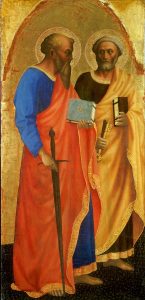
Looking at these Acts
“The Book of Acts records or reports that there was a special event that took place at Pentecost, which would have been the next pilgrimage festival after the Passover at which Jesus died. And at that time the disciples of Jesus were gathered together in Jerusalem, unsure of what their future would be, when all of a sudden the spirit took hold of them and enabled them to speak in tongues, and that speaking of tongues is understood by the author of the Book of Acts to mean speaking in all of the languages of the world. So with the power of the spirit behind them, the disciples of Jesus immediately began a missionary campaign and started bringing people into the fold, converting them to belief in Christ. And from that time forward the mission moved ahead in the rather smooth way, directed by the spirit and by all of the apostles who acted in concert with one another and agreement with one another. That’s the picture that we get in Acts.” Harold Attridge[1]
Reality concerning the spread of the Jesus-followers is perhaps a bit messier than the accounts we have in the book of Acts. Acts is the closest thing the Christian scriptures have to a history book–and it is still clearly not anything like a modern history book! Acts, like the gospels, is written with very specific goals in mind. It contains various stories set in the very beginning years of the church, and focuses, primarily, on the work of Peter in Jerusalem with the earliest converts, and later, with the work of Paul and others spreading the word among both Jewish and Gentile people who lived all around the Roman Empire. Because a whole variety of people (not just Peter and Paul) took their version of the message about Jesus to a whole variety of places, soon different emphases, different areas of focus, and different issues of conflict arose within the body of believers. Some believers really cared about the resurrection. Some were far more concerned with the moral teachings. Some felt the messianic ideas to be vital, and others never mentioned Jewish prophecy to their listeners. Some of the stories in Acts serve to demonstrate how the earliest believers shared their perspectives and their stories. And some of the stories share how the church eventually solved a few of the key conflicts surrounding religious belief and practice in the early communities.
The Structure of Acts
Acts starts with a short prologue, in Acts 1:1-11. In this prologue, the writer reminds the reader that this material was assembled for his friend Theophilus (a real or symbolic person?) summarizing what happened in the gospel of Luke, and then describing the ascension of Jesus at the end of the 40 day period after the resurrection.
After the prologue, the body of the book of Acts is then is divided into two big sections. In the first section, Acts 1:12 through the beginning of chapter 8, Luke describes the time before Gentiles became part of the community of Jesus followers, traditionally called the Way. The church at this point is a Jewish community, the believers mostly live in Judea and Jerusalem, the people worship together, they even spend a lot of time in the Jewish temple. This is very much a Jewish organization.
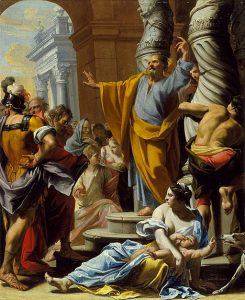
In this first section of Acts the stories include the choice of a new disciple to fill out the number to 12 again, the coming of the Holy Spirit at Pentecost, accounts of Peter preaching and healing throughout Jerusalem, interesting descriptions of the kinds of things that took place in the daily lives of the believers, Stephen’s story and martyrdom, and the beginning description of the persecution of these Jerusalem believers by an angry Pharisee named Saul.
Then comes a transition period from Acts 9 to 12:25. It starts with the conversion of Saul, who sees a vision of Jesus while on the road, as he was planning arrest any followers of the Way that might be found in Damascus. Then comes the conversion of the “first” Gentile convert, the Roman Cornelius, with Peter defending this conversion and baptism of Cornelius. It was controversial to bring someone into the church without them being circumcised at this point. Peter defends his decisions, and the people in Jerusalem eventually agree to this new acceptance of Gentiles.
After all this, look at Acts 11:19-30:
Now those who were scattered, because of the persecution that took place over Stephen, traveled as far as Phoenicia, Cyprus, and Antioch. And they spoke the word to no one but Jews. But among them were some men from Cyprus and Cyrene who on coming to Antioch spoke to the Hellenists also, proclaiming the Lord Jesus.
Some texts use the term “Hellenists”, which would be Greek speaking Jews, and other manuscripts have just the word “Greeks.” There is some idea that these people were speaking not just to Greek–speaking Jews but also to Greek Gentiles. That idea introduces, then, this period of the Gentiles.
An introduction to a predominantly Gentile church in Antioch takes place, and that is in 11:19-30 followed by persecution in Jerusalem in Chapter 12, and then a more visible shift of attention from believers in Jerusalem to the Gentiles converts in 12:25:
But the word of God continued to advance and gain adherence. Then after completing their mission, Barnabus and Saul returned to Jerusalem and brought with them John, whose other name was Mark.
From chapter 13 through the rest of Acts, the focus is not Jerusalem. Paul goes back to Jerusalem several times, and is eventually arrested in Jerusalem. But most of the rest of Acts describes what is happening away from Jerusalem, in the rest of the Roman world.
So from chapter 13:1 comes the period called “after the Gentiles,” with Gentiles having been brought into the church. Acts describes the first missionary journey of Paul, the Jerusalem conference in chapter 15, then the second missionary journey of Paul, the third missionary journey of Paul, and finally at last Paul visits once again in Jerusalem and while there is arrested and taken to Rome. At the end Paul is in Rome, ending the whole book of Acts, in chapter 28:17-31.
Two Stories
Acts presents, in two specific stories, some key ideas that took hold in the early church. Peter’s story shows the acceptance that even the believers in Jerusalem acquired for Gentile followers becoming members of the Way. The second story, the conversion of Saul, shows that even an enemy can become a friend of the Way. No one who believes, not even someone who had been persecuting and killing the believers, should be turned away from the community of the church if they have found faith. God will choose whom God will choose to lead the church. Who would have guessed that Saul would turn out to be so important to the faith?
These are powerful ideas, and they become crucial in the expansion of the membership of the church.

Peter and Cornelius
Look first at the story of Peter and Cornelius, found in Acts 10. It actually comes second in Acts after the conversion of Saul, but the issue of Gentiles in the church is front and center for everything that happens, including Paul’s missions beyond Palestine.
Peter’s story is a longer one, but the basics of the story go like this: a Roman named Cornelius has a vision, and is troubled by it. The vision tells him to send for a man named Simon Peter, who will help him understand it. So Cornelius sends for Peter. Peter, in the meantime, has also had a vision, and his vision contains images of all kinds of animals that Judaism does not consider kosher to eat. But God in this vision tells Peter that anything that God has made cannot be considered unclean. And Peter is also troubled by what this might mean. But Peter is only baffled by it all until he goes to see Cornelius, somewhat against his inclination and against Jewish tradition, and finds that Cornelius has had a visitation from God, too. Suddenly Peter’s own vision is made clear. Here is what he realizes, and preaches, both to the people who came with him, and to those who are there within Cornelius’ household:
Then Peter began to speak to them: “I truly understand that God shows no partiality, 35 but in every people anyone who fears him and practices righteousness is acceptable to him. 36 You know the message he sent to the people of Israel, preaching peace by Jesus Christ—he is Lord of all. 37 That message spread throughout Judea, beginning in Galilee after the baptism that John announced: 38 how God anointed Jesus of Nazareth with the Holy Spirit and with power; how he went about doing good and healing all who were oppressed by the devil, for God was with him. 39 We are witnesses to all that he did both in Judea and in Jerusalem. They put him to death by hanging him on a tree, 40 but God raised him on the third day and allowed him to appear, 41 not to all the people but to us who were chosen by God as witnesses and who ate and drank with him after he rose from the dead. He commanded us to preach to the people and to testify that he is the one ordained by God as judge of the living and the dead. 43 All the prophets testify about him that everyone who believes in him receives forgiveness of sins through his name”. While Peter was still speaking, the Holy Spirit fell upon all who heard the word. 45 The circumcised believers who had come with Peter were astounded that the gift of the Holy Spirit had been poured out even on the gentiles, 46 for they heard them speaking in tongues and extolling God. Then Peter said, 47 “Can anyone withhold the water for baptizing these people who have received the Holy Spirit just as we have?” 48 So he ordered them to be baptized in the name of Jesus Christ.
When Peter returned to Jerusalem, he told this whole story to the believers there, who were not happy at first. But Peter stuck to his new belief and says this to them in Acts 11:17-18:
“If then God gave them the same gift that he gave us when we believed in the Lord Jesus Christ, who was I that I could hinder God?” 18 When they heard this, they were silenced. And they praised God, saying, “Then God has given even to the gentiles the repentance that leads to life.”
The transition here from preaching only to the Jews is started with the story of Peter–and perhaps it is even appropriate to call this Peter’s conversion! He has a startling revelation about how this good news that he has been bringing to his own people could be important to others beyond the Jewish faith. It is a huge revelation, and helps set the path for Christianity in the future.
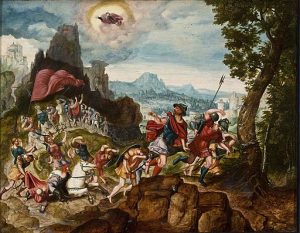
The Conversion of Paul
The other key story is the conversion of Saul on the road to Damascus. This conversion takes place in Acts 9:1-19
Chapter 8 has describe Saul as a persecutor of early followers of Jesus, and chapter 9 opens with Saul on the road, off to Damascus to arrest any followers of the Way that he might find there, to bring them to Jerusalem on blasphemy charges.
“Now as he [Saul] was going along and approaching Damascus, suddenly a light from heaven flashed around him. 4 He fell to the ground and heard a voice saying to him, “Saul, Saul, why do you persecute me?” 5 He asked, “Who are you, Lord?” The reply came, “I am Jesus, whom you are persecuting. 6 But get up and enter the city, and you will be told what you are to do.” 7 The men who were traveling with him stood speechless because they heard the voice but saw no one. 8 Saul got up from the ground, and though his eyes were open, he could see nothing; so they led him by the hand and brought him into Damascus. 9 For three days he was without sight and neither ate nor drank.
Now there was a disciple in Damascus named Ananias. The Lord said to him in a vision, “Ananias.” He answered, “Here I am, Lord.” 11 The Lord said to him, “Get up and go to the street called Straight, and at the house of Judas look for a man of Tarsus named Saul. At this moment he is praying, 12 and he has seen in a vision a man named Ananias come in and lay his hands on him so that he might regain his sight.” 13 But Ananias answered, “Lord, I have heard from many about this man, how much evil he has done to your saints in Jerusalem, 14 and here he has authority from the chief priests to bind all who invoke your name.” 15 But the Lord said to him, “Go, for he is an instrument whom I have chosen to bring my name before gentiles and kings and before the people of Israel; 16 I myself will show him how much he must suffer for the sake of my name.” 17 So Ananias went and entered the house. He laid his hands on Saul and said, “Brother Saul, the Lord Jesus, who appeared to you on your way here, has sent me so that you may regain your sight and be filled with the Holy Spirit.” 18 And immediately something like scales fell from his eyes, and his sight was restored. Then he got up and was baptized, 19 and after taking some food, he regained his strength.
Needless to say, the followers of the Way did not trust this new version of Saul. He started preaching about Jesus in Damascus, and had to sneak out, as he was not popular with the Jewish synagogue there. And so Saul/Paul came to Jerusalem.
Paul’s pattern for preaching, according to Acts at least, is actually established beginning with this story in Damascus. Paul goes to a town, and always first to the synagogue in the town, where he preaches to the Jews. Every time, some of them accept his words as true, but the majority of them don’t. Mostly they reject Paul, they throw him out of the synagogue, they try to stone him, or they even try to throw him out town. Then Paul turns and preaches the same message to the Gentiles in that town, and they accept him more readily, and the believers eventually form a church. Paul goes from town to town in this manner–it is this theme of the prophets (apostles and disciples) being rejected by the Jews that causes the message then to be taken to the Gentiles. That theme will play out over and over again in Acts.
Look at chapter 11:19, as it is very important to see what Luke is doing within the structure of the transitional chapters:
Now those who were scattered, because of the persecution that took place over Stephen, traveled as far as Phoenicia, Cyprus, and Antioch, and they spoke the word to no one except Jews. But among them were some men of Cyrus and Cyrene who, on coming to Antioch spoke to the Hellenists also, proclaiming the Lord Jesus. The hand of the Lord was with them, and a great number became believers and turned to the Lord. News of this came to the ears of the church in Jerusalem, and they sent Barnabas to Antioch. When he came and saw the grace of God, he rejoiced, and he exhorted them all to remain faithful in the Lord with steadfast devotion for he was a good man, full of the Holy Spirit and of faith. And a great many people were brought to the Lord. Then Barnabas went to Tarsus to look for Saul, and when he found him he brought him to Antioch. So it was that for an entire year they met with the church and taught a great many people, and it was in Antioch that the disciples were first called Christians.
In that little paragraph Luke shifts the focus of the church from the Jerusalem and the Jewish oriented form of the movement, to this predominantly Greek speaking city, Antioch. He is describing something new happening here, as this describes disciples who are not just speaking to Aramaic-speaking Jews or to Greek-speaking Jews, they are actually speaking to non-Jews. This is the first time in the book of Acts that the movement has spread out from Jerusalem, and it is clearly being spread to ethnic Greeks, which really means non-Jewish Greeks.
There are Greek speaking Jews who have Greeks names in the church, and Stephen is one of them. In fact, the seven deacons who are appointed in Acts are appointed precisely to be able to minister to the Greek speaking Jews, because some Greek speaking widows were being neglected in the distribution of food and funds. Stephen catches the attention of the authorities for his preaching and his charitable work, and because of his beliefs, ends up being killed by stoning.
Right after the stoning of Stephen, chapter 8:1-4 says this:
And Saul approved of their killing him [Stephen]. That day a severe persecution began against the church in Jerusalem, and all except the apostles were scattered throughout the countryside of Judea and Samaria. Devout men buried Stephen and made loud lamentation over him. But Saul was ravaging the church by entering house after house, dragging off both men and women, he committed them to prison. Now those who were scattered, after the stoning of Stephen, went from place to place proclaiming the word.
It seems, in narrative flow and storyline, that chapter 8:4 must have originally joined on to Acts 11:19 because this narrative style storytelling stops here at 8:4, and then it picks up again in 11:19, right where it left off several chapters earlier.
What Luke has done is split the more generalized version of the story, and put chapters 8, 9, and 10 and the first part of 11 in between two otherwise connecting segments. Why did Luke split a narrative and put this material in between? What’s in that material between 8, 9, 10, and 11 that Luke inserted? Phillip, Saul becoming Paul, but even more important–Peter preaching to Cornelius, the Gentile.
The first preachers of the Way, and the first non-Jewish listeners are anonymous. There is no knowing who they are, according to this short passage in Acts 8:1-4. They are just some Greek speaking followers of Jesus who left Jerusalem and Judea, traveled to the Eastern Mediterranean, and as they went they took the Gospel with them. Along the way they spoke not only to Greek speaking Jews but also to Gentiles.
Luke splits that anonymous story narrative into 2 pieces. After Acts 8:4, the story suddenly reverts to Phillip preaching in Samaria. Then comes the conversion of Saul. Then comes Peter up on the rooftop praying and seeing this sheet with all these unclean animals in it, and a voice from heaven saying, “What God has cleansed don’t you declare unclean”. The vision happens three times. Why three times? Because Peter does not want to take the message of Jesus to Gentiles. But finally Peter is forced to take the message to Gentiles by God, by this revelation, and he baptizes Cornelius and his house, the first Gentile converts.
Luke really wants Peter portrayed as being the first person to take the message to the Gentiles, and he wants Peter to do so only after being compelled by God to do so. Luke knows that the first people who took the message to Gentiles were probably just anonymous followers of Jesus, because in the source for Acts 8 it states that reality quite clearly. Luke splits that source, however, and he adds Peter’s story there in the middle of a more general narrative because he wants Peter to be the first one, and only then do the anonymous “others” get credit for preaching to Gentiles.
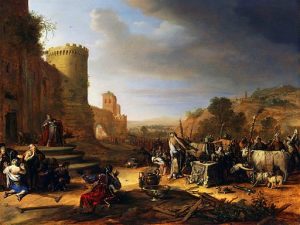
The Geography of Acts
Once the storyline is joined up again in Acts 11:19, the mission to the Gentiles becomes the main focus of Acts. Acts 13:46 shows Paul and Barnabas speaking on the Sabbath day to a crowd in a synagogue and some of the people believe, and some get jealous.
“Then both Paul and Barnabas spoke out boldly saying, “It was necessary that the word of God should be spoken first to you [that is to the Jews]. Since you reject it and judge yourselves to be unworthy of eternal life, we are now turning to the Gentiles.”
The same thing is said in Acts 18:6 and in 26:20. Over and over again Paul goes to a town, first to the synagogue with mixed success, so eventually turning to the Gentiles. But he never gets to a point where he finally and completely turns away from the Jews, as he keeps going back to the Jews in every town he gets to. This idea that the message must be preached first to the Jews and only then to the Gentiles, is a point that Acts makes over and over again.
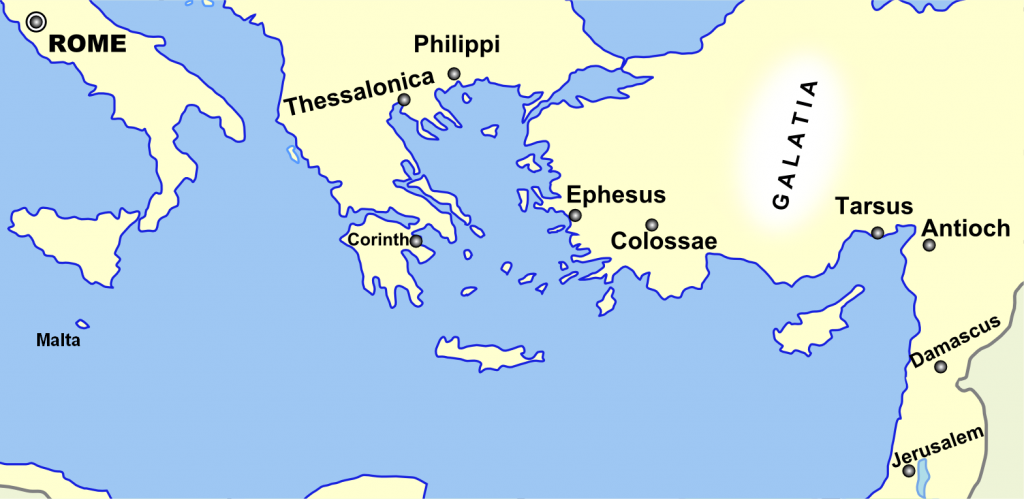
Paul’s three missions are described in the second half of Acts, between chapters 13-21. It is estimated that he spent about 12 years journeying back and forth from Jerusalem to the eastern Mediterranean, and eventually his story and travels have him ending up in Rome. A great deal of information about his ideas and beliefs show up in the letters of Paul to the various groups in these churches. The first of his journeys happened about 46-49 CE, when he then returned for a Council in Jerusalem. In late 49 CE he left again on a second journey, only returning to the area about 52 CE. Paul spent almost a year in the region, and left on a last journey, returning to Jerusalem with monetary gifts for the poor of the church in about 57 CE. Here he came into conflict with the Jews of Jerusalem, and was arrested by the Romans.
Example: check out this resource! Paul’s journeys
You can use this interactive map to check out the 3 different journeys of Paul, plus his route to Rome at the end. You will see instructions on its use once you get there:
While Paul was in Jerusalem after his third journey, he was actually trying to go worship in the temple. Some of the Jews who didn’t like Paul thought he was trying to take Gentiles into the temple, however, which would have been against Jewish ritual law. So they grab Paul, a big riot ensues, and the people take Paul before the Jewish Sanhedrin and put him on trial. Paul’s message in all of this chaos is, more or less,” I didn’t do anything wrong, I’m just here to obey the law, I’m here to serve my people, to honor the traditions of my people, I am a Jew”. Eventually such a big dispute arises that Paul is arrested by the Roman governor in order, he says, to protect Paul from being lynched. Paul is afraid he is going to lose a local trial if it happens in front of his Jewish enemies, so he appeals to the Roman governor, asking to be sent straight to the Emperor. Paul says, “I’m a Roman citizen, I appeal to the Emperor”, and this immediately means that he has to go to Rome for a trial.
So Paul ends up in Rome, after a dramatic journey to get there. He may be under arrest, but he is allowed to live independently. Paul preaches there, rents a hall where he again conducts classes and conducts sermons, and generally continues his ministry.
The end of Acts includes a final sermon by Paul that he gives to the Jewish leaders and elders. Notice how it ends, describing Paul’s life not his death, in Acts 28:28-31:
“Let it be known to you then that this salvation of God has been sent to the Gentiles. They will listen.” He [Paul] lived there two whole years at his own expense. He welcomed all who came to him, proclaiming the kingdom of God and teaching about the Lord Jesus Christ with all boldness and without hindrance.
In other words, the very end of the two-volume work ends with this message that the Gospel was preached initially to the Jews, but that they had rejected it. So Paul and the others who were preaching this message went to speak the Gentiles. Paul ends up in Rome, the capital of the whole (western) world, which represents the idea that the Gospel has now proceeded to the “whole world”.
Isn’t it interesting that this author doesn’t tell us what happened to Paul?
Acts claims that Paul was a Roman citizen. According to Roman tradition, a Roman citizen cannot be crucified. So the longstanding oral tradition within Christianity was that Paul was martyred, but not crucified, instead, Paul was beheaded in Rome, probably sometime in the 60s.
Why doesn’t Luke tell that story? Wouldn’t that be the more logical end of the book of Acts? He has talked about Paul’s call and ministry, he has told about Paul’s different missionary journeys, and he yet he ends up showing Paul as living in rented rooms in Rome.
All prophets and all messengers of the Gospel, according to this author, are martyred and rejected. Jesus was one of them, portrayed by Luke as a martyred prophet to the Jews. Stephen was a prophet and a martyr. And so, too, Paul ends up as a prophet to the Jews. When they reject him, he ends up a martyr, in spite of all the people in authority saying, “We believe you are innocent, but our hands are tied.”
Ending the book of Acts with a death, however, seems an abrupt stop to the message of the Gospel traveling throughout the Roman empire. The last sermon of Paul is, instead, a more hopeful and positive message that Paul is still preaching, the Gentiles are listening, and the message continues on.

Rouse, Robert. “Map of Paul’s Missionary Journeys.” Viz.Bible, 5 July 2018, https://viz.bible/journeys/.
Turner, Geoffrey. “Pauline Christology: An Exegetical-Theological Study. By Gordon D. Fee.” Heythrop Journal, vol. 50, no. 1, 2009, pp. 147–148., https://doi.org/10.1111/j.1468-2265.2009.00438_31.x.
Meeks, Wayne A, et al. “Paul’s Mission and Letters | from Jesus to Christ – the First Christians | Frontline.” Frontline: from Jesus to Christ, Public Broadcasting Service, https://www.pbs.org/wgbh/pages/frontline/shows/religion/first/missions.html.
Attridge, Harold, et al. “The Diversity of Early Christianity | from Jesus to Christ – the First Christians | Frontline.” Frontline: from Jesus to Christ, Public Broadcasting Service, https://www.pbs.org/wgbh/pages/frontline/shows/religion/first/diversity.html.
May, Herbert G., et al. The New Oxford Annotated Bible with the Apocrypha: Revised Standard Version, Containing the Second Edition of the New Testament and an Expanded Edition of the Apocrypha. Edited by Michael D Coogan, Oxford University Press, 2007.
Gabel, John B. The Bible as Literature: An Introduction. Oxford University Press, 2006.
Dale Martin, Introduction to the New Testament, Yale University: Open Yale Courses, http://oyc.yale.edu. License: Creative Commons BY-NC-SA . Most of the lectures and course material within Open Yale Courses are licensed under a Creative Commons Attribution-Noncommercial-Share Alike 3.0 license. Unless explicitly set forth in the applicable Credits section of a lecture, third-party content is not covered under the Creative Commons license.
- The Lillian Claus Professor of New Testament Yale Divinity School ↵
